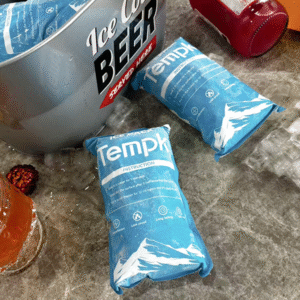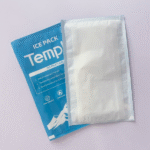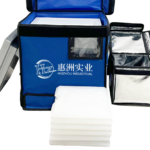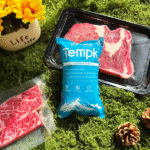Trockeneis-Packblätter für die Gastronomie: Die ultimative Lösung für einen sicheren und effizienten Kühlkettenversand
Die Aufrechterhaltung der Qualität und Sicherheit verderblicher Lebensmittel während des Transports ist in der Gastronomiebranche von entscheidender Bedeutung. Trockeneis-Packplatten für die Gastronomie werden zunehmend zur Lösung der Wahl, wenn es darum geht, temperaturempfindliche Lebensmittel frisch zu halten. Diese Laken sorgen für eine ultrakalte Atmosphäre, trockene Lösung, Bietet eine bequeme und kostengünstige Möglichkeit, sicherzustellen, dass Lebensmittel während des Ferntransports gefroren oder gekühlt bleiben. In diesem Artikel, Wir werden untersuchen, wie Trockeneisbeutel funktionieren, Die Vorteile, die sie bieten, und die besten Praktiken für deren Verwendung zur Aufrechterhaltung der Lebensmittelqualität.

-
Was sind Trockeneisplatten für die Gastronomie und wie funktionieren sie??
-
Warum sind sie die beste Wahl für Catering-Dienstleistungen??
-
Die Vorteile der Verwendung von Trockeneis im Transportwesen.
-
So wählen Sie die richtige Größe und Menge für Ihre Bedürfnisse aus.
-
Trends im Kühlkettenversand und Innovationen in 2025.
Was sind Trockeneisplatten für die Gastronomie und wie funktionieren sie??
Trockeneis-Packplatten für die Gastronomie sind flexibel, Mehrzellige Decken gefüllt mit hochreines Kohlendioxid (Co₂). Diese Platten sind so konzipiert, dass sie extrem niedrige Temperaturen aufrechterhalten, indem sie CO₂ von fest zu gasförmig sublimieren, die Wärme aufnimmt, ohne Feuchtigkeitsrückstände zu hinterlassen. Dadurch sind sie ideal für den Einsatz in der Gastronomie geeignet, da sie verhindern, dass Lebensmittel durchnässt werden – im Gegensatz zu herkömmlichen Eisbeuteln, die schmelzen und Wasser abfließen lassen.
Wie Sublimation funktioniert:
Beim Sublimationsprozess geht CO₂ direkt von einem Feststoff in einen Gaszustand über, Dabei nimmt es Wärme auf. Dies führt zu einer Kühlung, ohne dass große Eis- oder Wassermengen erforderlich sind. Trockeneis erreicht Temperaturen von bis zu -78.5°C (-109.3° F), Damit können Tiefkühlkost und verderbliche Lebensmittel während des Transports oder bei Veranstaltungen effektiv auf der optimalen Temperatur gehalten werden.
Schlüsselmerkmale:
-
Ultraniedrige Temperatur: Trockeneis kann Temperaturen deutlich unter dem Gefrierpunkt halten, Dadurch eignet es sich für Tiefkühlkost wie Eiscreme, Fleisch, und Meeresfrüchte.
-
Keine flüssigen Rückstände: Im Gegensatz zu traditionellem Eis, Trockeneis untermauert direkt in Gas, Es bleiben keine Wasserrückstände zurück, die das Lebensmittel oder die Verpackung beschädigen könnten.
-
Flexibles Design: Die mehrzellige Deckenstruktur passt sich Kühlboxen und Tabletts an, Bietet vollständige Abdeckung für verschiedene Größen von Behältern und Produkten.
Warum sind Catering-Trockeneisplatten die beste Wahl für Catering-Dienstleistungen??
Für Caterer, Es ist von größter Bedeutung, sicherzustellen, dass Lebensmittel frisch und sicher ankommen. Trockeneis-Packplatten für die Gastronomie sind aufgrund mehrerer Vorteile gegenüber herkömmlichen Kühlmethoden wie Gel-Packs oder Wassereis oft die beste Wahl.
Verlängerte Kühldauer:
Trockeneis kann für Abkühlung sorgen 24-48 Std., deutlich länger als Gelpackungen, was normalerweise anhält 6-12 Std.. Dies ist von entscheidender Bedeutung für Ferntransporte oder längere Veranstaltungen, bei denen möglicherweise keine Kühlung verfügbar ist.
Kosteneffizienz:
Während Trockeneis zunächst wie eine teurere Option erscheinen mag, Es spart auf lange Sicht Geld, da die Lebensmittelqualität erhalten bleibt und der Verderb reduziert wird. Das verringerte Risiko des Verderbens von Lebensmitteln bedeutet auch weniger Produktverluste.
Umweltfreundlich:
Trockeneis wird hergestellt aus recyceltes Kohlendioxid, die bei industriellen Prozessen erfasst wird. Infolge, Die Verwendung von Trockeneis für den Lebensmitteltransport kann als nachhaltigere Option angesehen werden als herkömmliches Eis oder synthetische Kältemittel.
Die Vorteile der Verwendung von Catering-Trockeneisplatten im Transportwesen
Verwendung Trockeneis-Packblätter in der Gastronomie bietet mehrere Vorteile, die über das bloße Kühlhalten von Speisen hinausgehen. Diese Laken verbessern die Gesamtqualität Ihres Catering-Services, indem sie kritische Probleme wie Feuchtigkeitsschäden beseitigen, Verderb, und Wirtschaftlichkeit.
Schlüsselvorteile:
-
Längere Kühldauer: Trockeneis behält seine kühlende Wirkung bis zu 48 Std., Damit eignet es sich perfekt für Veranstaltungen, abgelegene Orte, oder Übernachtsendungen.
-
Keine Wasserschäden: Im Gegensatz zu traditionellem Eis, Trockeneis schmilzt nicht in Wasser, Stellen Sie sicher, dass Ihre Lebensmittelverpackung intakt und Ihre Produkte trocken bleiben.
-
Zuverlässigkeit: Trockeneis-Packplatten für die Gastronomie bieten eine konstante Kühlleistung, Wir geben Caterern die Gewissheit, dass ihre Produkte im bestmöglichen Zustand ankommen.
| Kühllösung | Kühldauer | Ideale Anwendungen | Vorteile |
|---|---|---|---|
| Trockeneisplatten für die Gastronomie | 24-48 Std. | Meeresfrüchte, Fleisch, gefrorenes Essen | Längere Kühlung, keine Wasserrückstände, hohe Zuverlässigkeit |
| Gelpackungen | 12-24 Std. | Molkerei, Früchte | Flexibel, wiederverwendbar, kostengünstig |
| Traditionelle Eisbeutel | 6-12 Std. | Kurzstreckenversand | Preiswert, weit verbreitet |
Welche Arten von Lebensmitteln profitieren am meisten von Catering-Trockeneis-Packplatten??
Nicht alle Lebensmittel benötigen das gleiche Maß an Kühlung. Trockeneis-Packplatten für die Gastronomie eignen sich besonders für bestimmte Arten von Lebensmitteln. Dazu gehören:
Gefrorene Lebensmittel:
Trockeneis sorgt für gefrorene Lebensmittel, wie zum Beispiel Eiscreme, gefrorenes Fleisch, Und Geflügel, während des Transports auf den erforderlichen niedrigen Temperaturen bleiben.
Meeresfrüchte:
Frische Meeresfrüchte reagieren besonders empfindlich auf Temperaturschwankungen, und Trockeneis verhindert das Auftauen, sorgt dafür, dass die Meeresfrüchte frisch bleiben, sicher, und frei von Bakterienwachstum.
Milchprodukte:
Käse, Milch, und andere Milchprodukte müssen bei bestimmten Temperaturen aufbewahrt werden, um ein Verderben zu verhindern. Trockeneis trägt dazu bei, die Qualität dieser Produkte zu erhalten, auch beim Ferntransport.
Bester Tipp für Caterer:
Für eine Vielzahl von Lebensmitteln, Erwägen Sie zu verwenden Trockeneis für verderbliche Produkte wie Fleisch und Meeresfrüchte, Und Gelpackungen für weniger empfindliche Speisen wie Obst oder bestimmte Desserts. Diese Hybridmethode optimiert sowohl die Kosten als auch die Kühleffizienz.
2025 Trends in der Kaltkette -Logistik
Während wir uns bewegen 2025, Innovationen im Bereich Kühlkettenlogistik prägen die Zukunft der Gastronomie. Hier ist ein Blick auf die wichtigsten Trends, die Sie im Auge behalten sollten:
Intelligente Logistik und Temperaturüberwachung:
Echtzeit-Temperaturüberwachungsgeräte werden zum Standard, So können Caterer den Zustand ihrer Waren während des Transports überwachen.
Nachhaltige Verpackung:
Der Schwerpunkt liegt zunehmend auf biologisch abbaubaren und recycelbaren Verpackungsmaterialien als Ergänzung zu Trockeneis-Kühllösungen. Dieser Trend wird durch wachsende Umweltbedenken vorangetrieben.
Automatisierung in der Kühlkettenlogistik:
Automatisierte Verpackungssysteme werden immer fortschrittlicher, Reduzierung der Arbeitskosten und menschlicher Fehler bei gleichzeitiger Verbesserung der Effizienz im Verpackungsprozess.
Sicherheitsüberlegungen für Trockeneis-Packplatten für die Gastronomie
Während Trockeneis sehr effektiv ist, es erfordert eine ordnungsgemäße Handhabung. Befolgen Sie diese Sicherheitsmaßnahmen, um Unfälle zu vermeiden:
Beste Sicherheitspraktiken:
-
Belüftung: Stellen Sie immer sicher, dass Behälter, die mit Trockeneis verwendet werden, über geeignete Entlüftungsöffnungen verfügen, damit das Gas entweichen kann.
-
Handschuhe und Zange: Tragen Sie beim Umgang mit Trockeneis immer isolierte Handschuhe, um Erfrierungen zu vermeiden.
-
Vermeiden Sie luftdichte Behälter: Verschließen Sie Trockeneis niemals in luftdichten Behältern, da dies zu einem gefährlichen Druckaufbau führen kann.
-
Beschriftung: Beschriften Sie Behälter ordnungsgemäß mit “Trockeneis (Und 1845)” und das Nettogewicht, um den Sicherheitsvorschriften zu entsprechen.
Häufig gestellte Fragen
1. Wie lange halten Trockeneisbeutel für die Gastronomie??
Trockeneisbeutel halten in der Regel zwischen 24 Zu 48 Std., abhängig von Faktoren wie Isolierung und Umgebungstemperatur.
2. Kann ich Trockeneis für den Versand aller Arten von Lebensmitteln verwenden??
Ja, Trockeneis eignet sich zum Transport verschiedenster Lebensmittel, insbesondere solche, die gefroren oder bei niedrigen Temperaturen bleiben müssen.
3. Ist der Umgang mit Trockeneis sicher??
Ja, Gehen Sie jedoch stets vorsichtig mit Trockeneis um. Verwenden Sie Handschuhe, Arbeiten Sie in gut belüfteten Bereichen, und verschließen Sie es niemals in luftdichten Behältern.
Schlussfolgerung und Empfehlungen
Trockeneis-Packplatten für die Gastronomie sind eine zuverlässige Lösung, wirksam, und umweltfreundliche Lösung, um Lebensmittel während des Transports frisch zu halten. Ihre lang anhaltende Kühlkraft, Vielseitigkeit, und ihre Umweltvorteile machen sie zu einem Muss für Gastronomiebetriebe. Ob Sie Tiefkühlkost transportieren, Meeresfrüchte, oder Milchprodukte, Trockeneis sorgt dafür, dass Ihre Waren in optimalem Zustand ankommen.
Nächste Schritte:
-
Bewerten Sie Ihre aktuellen Transportmethoden und erwägen Sie den Umstieg auf Trockeneisplatten für temperaturempfindliche Lebensmittel.
-
Investieren Sie in Temperaturüberwachungsgeräte, um optimale Bedingungen während des Transports sicherzustellen.
-
Führen Sie nachhaltige Verpackungslösungen ein, um Ihre umweltfreundlichen Praktiken zu verbessern und umweltbewusste Kunden anzusprechen.























